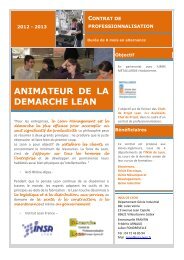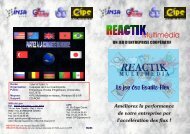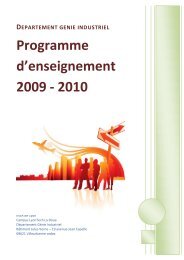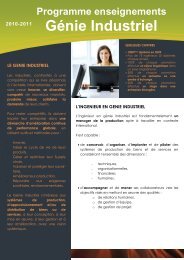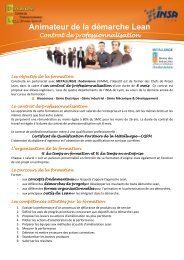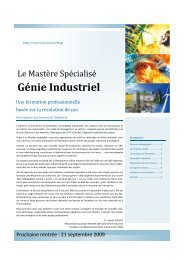Industrial Engineering Department - INSA de Lyon
Industrial Engineering Department - INSA de Lyon
Industrial Engineering Department - INSA de Lyon
You also want an ePaper? Increase the reach of your titles
YUMPU automatically turns print PDFs into web optimized ePapers that Google loves.
3 RD YEAR<br />
AUTOMATIC CONTROL AND SYSTEMS<br />
E3 – ENVIRONMENT, COMMAND CHAINS AND REALIZATION -<br />
Hydraulics, actuators, modulators<br />
Measuring chains<br />
Electric actuators<br />
Real case study – choice of actuators and sensors (guiding<br />
principles)<br />
T8 - PROGRAMMABLE LOGIC CONTROLER<br />
Or<strong>de</strong>rs of a rotary store by Grafcet<br />
Control of a system of congestion<br />
E4 - CONTROL, REGULATION and PID<br />
Signal processing, filtering<br />
Feed-back, feed-forward<br />
Frequency analysis<br />
Stability, precision<br />
Control, Regulation PID<br />
Controlled systems, correction by PID<br />
T2 – PROCESS CONTROL: PID<br />
Implementation of a real control system:<br />
Control of position and speed<br />
Temperature control<br />
Level regulation<br />
Vertical store programming<br />
P1 – CONTROL OF A ROBOTIZED SYSTEM<br />
Environment, sensors and information acquisition<br />
Transmission and effectors<br />
Or<strong>de</strong>ring algorithms<br />
Global system behavior<br />
E2 - SIMULATION OF SYSTEMS WITH DISCRETE EVENTS<br />
Typology of production systems<br />
Recall of probabilities and statistics<br />
Mo<strong>de</strong>ling approaches for simulation<br />
Analysis and validation of mo<strong>de</strong>ls<br />
Result analysis of and <strong>de</strong>cision support systems<br />
Mo<strong>de</strong>ling, analysis and evaluation of the performances of systems<br />
with discrete events, in particular production systems<br />
T1 – SIMULATION SED ARENA<br />
Introduction to simulation software and calculation usually used in<br />
companies.<br />
T9 SIMULATION OF CONTINUOUS SYSTEMS WITH MATLAB<br />
E12 - GRAPH THEORY<br />
Various representations of a graph<br />
Connectivity, strong components<br />
Shortest path<br />
Maximal matching, Maximum flow, Minimal spanning tree<br />
Introduction to mo<strong>de</strong>ling and optimization.<br />
E14 –PETRI NETS –<br />
This course aims to give the stu<strong>de</strong>nts, specialized in production systems, the<br />
tools and the methodologies of analysis and dimensioning. The studied<br />
systems are characteristic of systems whose states belong to a discrete<br />
space. Transitions from states are only observed at discrete moments of time,<br />
therefore they are called Systems with Discrete Events.<br />
The mo<strong>de</strong>ling tools used in this course are Petri nets whose structure (static<br />
mo<strong>de</strong>l) induces interesting properties, which allow validating the mo<strong>de</strong>l but<br />
also the studied system. By associating a <strong>de</strong>terministic temporal<br />
characteristic, this mo<strong>de</strong>l shows that it is possible to express performances<br />
quantitatively. Beyond the discovery of a mo<strong>de</strong>ling tool, this course teaches<br />
knowledge on the engineering environment and on system <strong>de</strong>sign and its<br />
terminology.<br />
E15 – STOCHASTIC PROCESSES<br />
This course aims to give the stu<strong>de</strong>nts, specialized in production systems, the<br />
tools and the methodologies for the analysis of stochastic systems. The<br />
studied systems concern systems with Discrete Events for which the<br />
transition moments are not <strong>de</strong>terministic any more but <strong>de</strong>pend on random<br />
phenomena. The mo<strong>de</strong>ling tools used in this course are Markov processes<br />
and queue networks. By expressing the equilibrium equations of these<br />
mo<strong>de</strong>ls it is possible to characterize the load indicator, which is very<br />
interesting for the evaluation of productivity but also of reliability<br />
COMPUTER SCIENCES<br />
E6 – DATA PROCESSING BASES<br />
Introduction (concepts of programming methods, programming<br />
languages, software quality)<br />
Objects and elementary actions<br />
Control structures, Procedures and functions<br />
Iterative Structures<br />
Classes and objects<br />
Polymorphism, sending of message<br />
The reasoning<br />
Knowledge mo<strong>de</strong>ling<br />
Structure of knowledge based system<br />
T3 – ALGORITHMS<br />
Design and <strong>de</strong>velopment of applications in the Java language un<strong>de</strong>r LINUX<br />
respecting the principal concepts seen in the course “Algorithms”.<br />
E7 – UML<br />
Mo<strong>de</strong>ling, UML diagrams in general<br />
Class diagrams in practice, Activity diagrams<br />
Associated tools<br />
T4 – OBJETCS<br />
Oriented Object <strong>de</strong>sign and application <strong>de</strong>velopment in Java language un<strong>de</strong>r<br />
Linux using mechanisms presented during the class “Object Oriented <strong>de</strong>sign”.<br />
E5 – COMPUTER ARCHITECTURE<br />
Design of a calculating unit<br />
Memory <strong>de</strong>sign<br />
Machine language<br />
Interrupts/Communication<br />
Memory management<br />
Processes<br />
Introduction to UNIX and Linux<br />
Description of the essential components of the architecture of a<br />
computer and its operating system.<br />
T19 – MULTI TASKING<br />
Study of the multi-tasking architecture of Linux<br />
E8 - DATA BASES<br />
What is a Data Base Management System?<br />
Mo<strong>de</strong>l entity –association, Relational Mo<strong>de</strong>l – Standardization<br />
Query language – Introduction to SQL<br />
T5 - SQL<br />
Creation of a database un<strong>de</strong>r Access, starting from a real case. Query using<br />
SQL requests<br />
T6 - XML<br />
Discovery of XML structure and associated technologies




